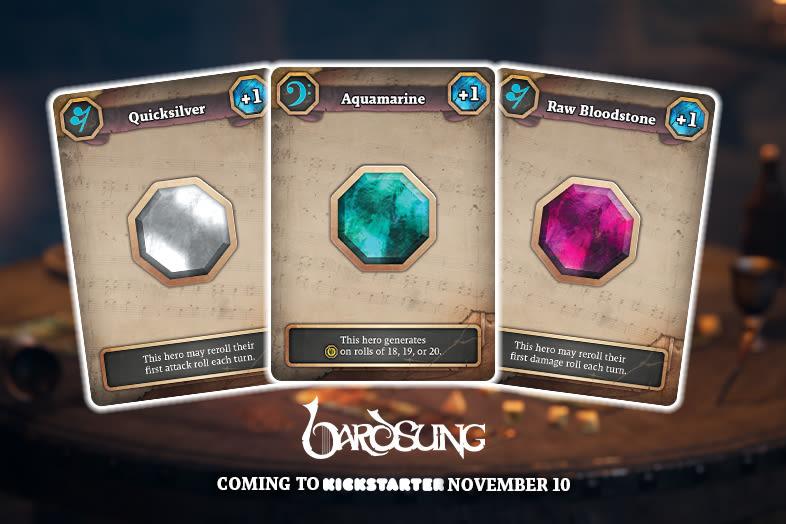Get Your Gemstones! Weapons & Equipment in Bardsung

Just one day 'til launch, heroes!
Make sure you're following the campaign.
Then, let's hand over to Sherwin to talk weapons, equipment, and shiny, shiny gems...
Weapons and Equipment in Bardsung
Today we’re covering another way to upgrade your heroes in Bardsung:
Equipment!
In fact, this might secretly be one of my favourite mechanics in the game right now because I’m riding a massive Japanese-roleplaying-game (JRPG) high.
Why is that relevant?
Let’s find out.
Equipment System Challenges
You’d think adding different weapons and armour into the game would be a relatively straightforward process.
In truth, equipment was something we went back and forth on the most in early design.
Let’s start, as we did, with a conventional approach:
Each hero begins with one or two pieces of equipment.
As the campaign continues, the heroes are able to find other pieces of equipment.
These might be new weapons, armour, or shields, each providing new rules and/or heightened stats, such as extra range, stopping power, or defence.
Now, in order to make that work, you also have to introduce a slot system based on body locations.
Otherwise, you invite strange situations where heroes are wielding two double-handed weapons, three shields, and four breastplates.
Although slot systems are perfectly functional (and indeed, I have several early playtest documents with exactly this format), this makes balancing the game a touch difficult which, of course, affects the gameplay experience.
Unless you make equipment drops completely fixed (such as when you defeat a certain boss, or reach a set location), it’s hard to ensure the equipment level of each hero remains consistent.
That means you have to tone down every enemy with the lowest potential hero in mind to avoid a negative play experience, where the heroes can’t actually damage or defend themselves against an enemy.
Go too far in that vein, and you create a new negative play experience—you make the game too easy.
And, to polish it off, we also didn’t like the interactions between the ability and equipment cards in terms of cross referencing.
Players were constantly looking in two places for die modifiers, rerolls, and special rules. Whilst we liked the customisation and variation, we really wanted a more accessible system with less potential for confusion.
So, we trialled several methods here before moving on.
Trials and Tribulations
The most obvious method involved limiting the equipment a hero could use based on their path and level, but that felt fundamentally counterintuitive to our class-less system.
Others were fun, but also added more complexity.
In fact, one of my favourites for armour was to determine what location enemies attacked on their cards.
That meant we could narrow beam equipment drops to match the enemy attacks the players would be suffering—imagine for example, a cunning enemy that always goes for the legs—and slowly expand on this until all heroes were fully armoured.
Whilst functional, the more we explored equipment, the more we found ourselves asking what it was we were trying to achieve in the first place.
And so, we stripped it right back and started again.
Going Non-Traditional
We wanted an accessible system that focused on first subtle enhancements, and then combinations and upscaled performance.
And the more we isolated the elements we wanted, the more we realised we were being tripped up by convention and preconceptions.
After all, when a hero gets a new weapon, it’s the gameplay requirements that matter. Not the visual.
In truth, it didn’t matter whether the Nightfeather was wielding a claymore or a pair of daggers, as long as the rules felt appropriate for hero progression and balance.
However, the conventional approach is to take a weapon and let the visual inform the rules and stats. We wanted to break from that.
Our solution was to strip back traditional weapon enhancement and create incremental steps instead.
Gemstones

Bardsung uses a gemstone system for granular equipment upgrades.
Each gemstone provides a bonus or effect which you can bind to a piece of equipment.
Starting equipment only allows for a single gemstone, limiting the potential for your hero to become too powerful and breeze through enemies!
This effectively replaces what would be more familiar to most as a ‘+1 sword’—an early weapon upgrade with limited potential.
Equipment Upgrades
Later in the game, you can upgrade your equipment in two ways.
The first is through multiple gemstone slots, which is where we get into serious customisation.
With this, you can combine gemstones for more balanced weapons, or skew really hard in one direction—damage or accuracy, for example.
The second is through inherent special rules and stats which are always applied to the equipment, irrespective of what gemstones are bound to the card.
These again offer potential for customisation and specialisation far beyond what a standardised equipment card can offer.
And remember I mentioned JRPGs earlier? This is where the immediate tie-in is for me.
It’s immediately evocative of several systems I’ve encountered in games and series like Final Fantasy™ and Vagrant Story™.
Passed Down for Generations
In terms of visuals, we’ve moved away from new equipment per se, so as to not break immersion, and to make it easy to see what equipment upgrades are available to your hero.
Instead, our theme is that each hero is upgrading their existing equipment, enhancing and building legendary heirlooms and treasures that will be passed through the ages.
The final part of the equipment system, which I’ll quickly touch on, is this:
All heroes have two pieces of equipment.
But whilst some heroes are balanced with one weapon and one piece of armour, allowing them to build defensive tech and offence tech, others begin with two weapons, or two pieces of armour, giving us another level of distinctiveness for each hero.
Sound fun? You can bet it is!







